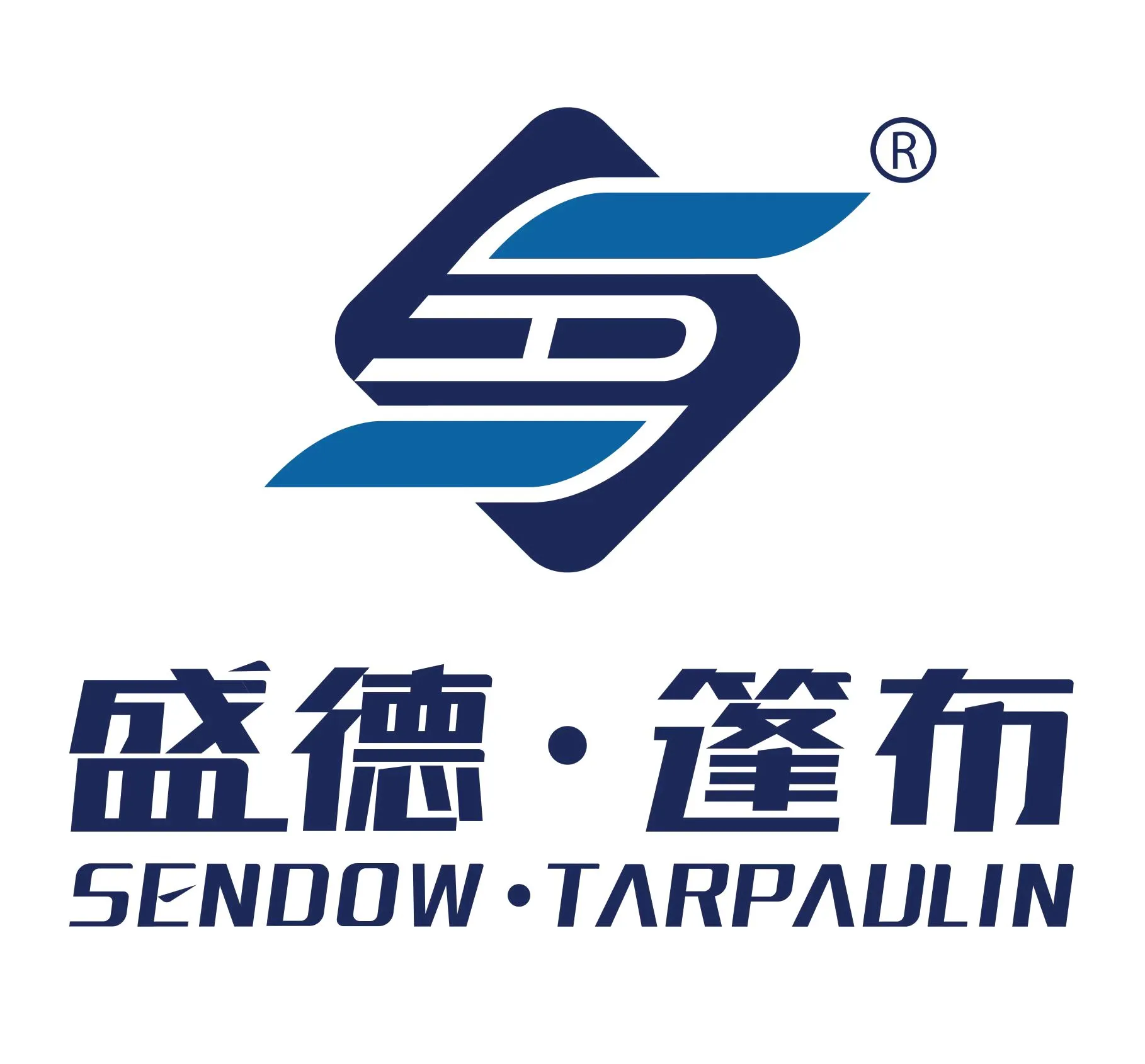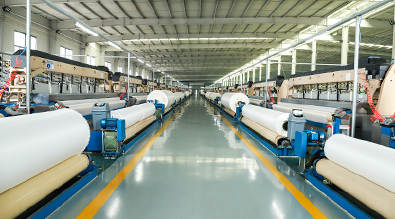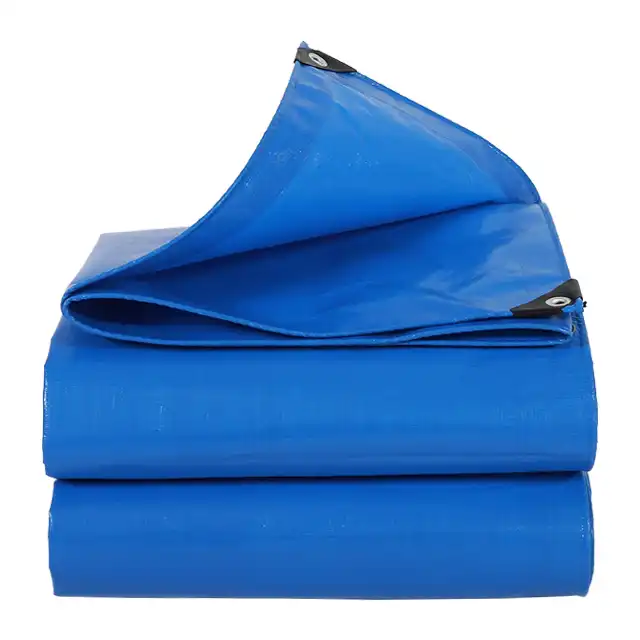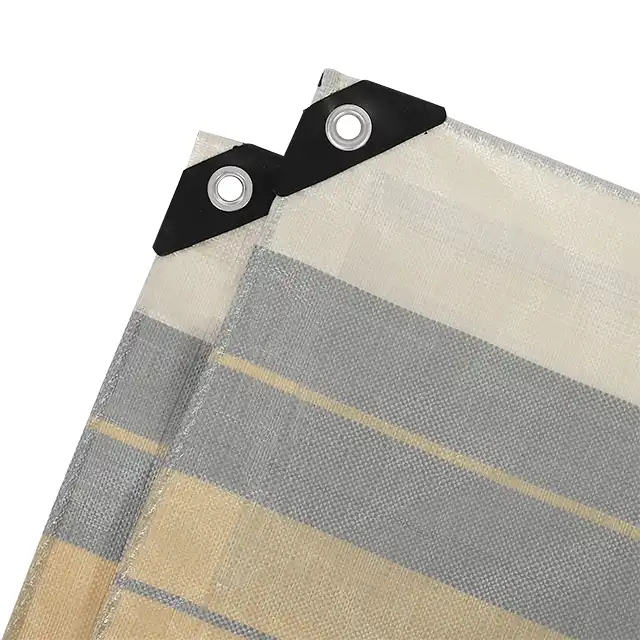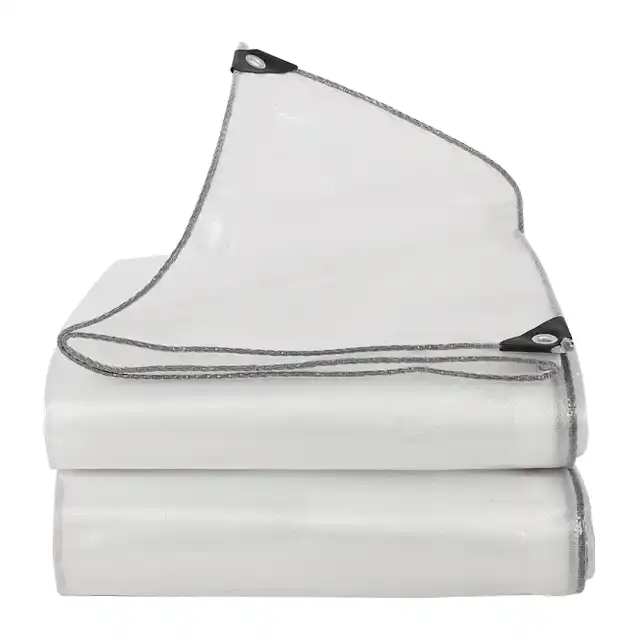PE Tarpaulin vs. Other Tarp Materials: What's the Difference
When it comes to protective coverings for various applications, understanding the differences between materials is crucial for making the right choice. PE Tarpaulin, short for polyethylene tarpaulin, has emerged as one of the most versatile and widely used materials in the industry. Unlike traditional canvas or vinyl options, PE tarpaulin offers a unique combination of durability, flexibility, and cost-effectiveness that makes it stand out in the market. This comprehensive guide explores the key differences between PE tarpaulin and other tarp materials, helping you understand why PE tarpaulin has become the preferred choice for numerous applications ranging from construction coverings to agricultural protection and emergency shelters.
Material Composition and Manufacturing Process
The Unique Structure of PE Tarpaulin
 PE Tarpaulin represents a significant advancement in protective covering technology. At its core, PE tarpaulin consists of high-density polyethylene (HDPE) woven fabric that is laminated with low-density polyethylene (LDPE) coating on both sides. This sandwich-like structure creates a material that combines the best of both worlds: the strength and tear resistance of woven fabric with the waterproof properties of polymer coating. The manufacturing process begins with the extrusion of HDPE yarn ranging from 400D to 2500D in thickness, which is then meticulously woven on specialized water-jet looms that can produce fabrics ranging from 1.5m to 5m in width without joints. This seamless construction is a particular advantage of PE tarpaulin over other materials, as it eliminates potential weak points. The final stage involves coating the woven fabric with LDPE through advanced coating machines operated by professional technicians who carefully control quality at every step. This multi-layer construction creates a material that is not only waterproof but also exhibits remarkable strength-to-weight ratio, making PE tarpaulin lighter yet stronger than many alternative materials on the market.
PE Tarpaulin represents a significant advancement in protective covering technology. At its core, PE tarpaulin consists of high-density polyethylene (HDPE) woven fabric that is laminated with low-density polyethylene (LDPE) coating on both sides. This sandwich-like structure creates a material that combines the best of both worlds: the strength and tear resistance of woven fabric with the waterproof properties of polymer coating. The manufacturing process begins with the extrusion of HDPE yarn ranging from 400D to 2500D in thickness, which is then meticulously woven on specialized water-jet looms that can produce fabrics ranging from 1.5m to 5m in width without joints. This seamless construction is a particular advantage of PE tarpaulin over other materials, as it eliminates potential weak points. The final stage involves coating the woven fabric with LDPE through advanced coating machines operated by professional technicians who carefully control quality at every step. This multi-layer construction creates a material that is not only waterproof but also exhibits remarkable strength-to-weight ratio, making PE tarpaulin lighter yet stronger than many alternative materials on the market.
Canvas and Vinyl: Traditional Alternatives
Traditional canvas tarps, typically made from cotton or canvas blends, have been used for centuries but come with significant limitations compared to PE tarpaulin. Canvas is naturally heavy, prone to mildew when wet, and requires special treatments to achieve water resistance—which often deteriorates over time. Canvas tarps also tend to shrink when exposed to moisture and expand when they dry, creating a constant cycle of dimensional changes that can affect their performance. Vinyl tarps, while more water-resistant than canvas, are significantly heavier than PE tarpaulin of equivalent strength. Vinyl manufacturing also involves more complex chemical processes and produces materials that are less environmentally friendly both in production and disposal. Additionally, vinyl tarps tend to become brittle in cold weather and can crack under stress in freezing conditions, while PE tarpaulin maintains its arctic flexibility even in extreme cold. Neither canvas nor vinyl offers the same combination of lightweight properties and tear resistance that characterizes quality PE tarpaulin products like those manufactured by Linyi Shengde Plastic Co., which uses high-strength yarn to provide extra UV protection against harmful sunrays and fading.
Mesh and Specialty Materials: Niche Applications
Mesh tarps and specialty materials serve specific purposes but differ substantially from PE tarpaulin in their design and functionality. Mesh tarps allow air to flow through while still providing some protection from debris and sun, making them suitable for scaffolding or as wind screens. However, they lack the waterproof properties that define PE tarpaulin. Specialty materials like fire-retardant or insulated tarps serve very specific needs but often at significantly higher cost points and with added weight. While these materials excel in their narrow applications, they lack the versatility of PE tarpaulin, which can be manufactured with various specialized treatments to meet different requirements. For instance, Sendow Tarpaulin offers PE tarpaulin with UV treatment ranging from 1% to 7%, allowing customers to select the appropriate level of sun protection for their specific application. The mesh count in PE tarpaulin can also be adjusted from 10x10 to 14x14, providing different levels of strength and flexibility. These customizable features allow PE tarpaulin to adapt to various applications while maintaining its core advantages of being 100% waterproof, tear-resistant, and highly durable, making it a more versatile choice than highly specialized alternatives that may excel in one area but fall short in others.
Performance Characteristics and Durability
Weather Resistance and Longevity
PE tarpaulin demonstrates exceptional weather resistance compared to other tarp materials, which explains its growing popularity in outdoor applications. The double-laminated construction of PE tarpaulin creates a completely waterproof barrier that prevents moisture penetration even during prolonged exposure to rain or snow. Unlike canvas tarps that can become waterlogged and heavy, or vinyl tarps that may crack in extreme temperatures, PE tarpaulin maintains its protective properties across a wide temperature range. The UV treatment incorporated into high-quality PE tarpaulin, such as those produced by Sendow Tarpaulin with UV protection ratings of 1%-7%, significantly extends the material's lifespan when exposed to harsh sunlight. This UV resistance prevents the common problem of degradation and color fading that affects many other tarp materials. The anti-freezing and arctic flexibility features of PE tarpaulin ensure it remains pliable and functional even in sub-zero temperatures, while many competing materials become brittle and prone to cracking. This temperature versatility makes PE tarpaulin suitable for use in diverse climatic conditions from tropical heat to arctic cold. Furthermore, the anti-corrosion properties of PE tarpaulin mean it won't deteriorate when exposed to mild chemicals, salt air, or industrial pollutants that might quickly degrade canvas or untreated alternatives. These combined weather-resistant properties contribute to the exceptional longevity of PE tarpaulin, which typically outlasts canvas tarps by years and often provides comparable service life to more expensive vinyl options while maintaining better flexibility throughout its useful life.
Strength-to-Weight Ratio and Handling Characteristics
The strength-to-weight ratio is where PE tarpaulin truly distinguishes itself from competing materials. Middle-duty PE tarpaulin, ranging from 100gsm to 180gsm in weight, offers remarkable tensile strength despite its lightweight nature. This efficiency is achieved through the high-density woven structure using specially engineered HDPE fibers that maximize strength while minimizing material bulk. Canvas tarps of comparable strength might weigh two to three times more than equivalent PE tarpaulin, making them more difficult to transport, install, and manipulate. Vinyl tarps, while strong, also suffer from excessive weight that complicates handling and increases shipping costs. The lightweight nature of PE tarpaulin makes it exceptionally easy to handle, fold, and store, providing practical advantages for users who need to frequently move or adjust their protective coverings. Additionally, PE tarpaulin's tear resistance is engineered into the material through the tightly woven base fabric, which prevents small punctures from developing into larger tears - a common failure point in canvas and lighter vinyl materials. The shrink-proof quality of PE tarpaulin ensures it maintains its dimensions over time and through varying weather conditions, unlike canvas which tends to contract when wet and expand when dry, potentially causing fit problems in applications requiring precise coverage. For applications requiring frequent repositioning or temporary installations, the easy handling characteristics of PE tarpaulin provide significant practical advantages over heavier alternatives, making it the preferred choice for applications ranging from construction site coverings to emergency shelters where quick deployment is essential.
Environmental Factors and Sustainability
In today's environmentally conscious market, the sustainability profile of materials has become increasingly important. PE tarpaulin offers several environmental advantages compared to alternative tarp materials. The manufacturing process for PE tarpaulin is relatively energy-efficient, especially when compared to the complex chemical processes required for vinyl production. High-quality PE tarpaulin, like those produced by Linyi Shengde Plastic Co., Ltd., can be manufactured with minimal waste through efficient extrusion and weaving processes that maximize material utilization. The durability of PE tarpaulin also contributes to its environmental profile, as longer-lasting products reduce the frequency of replacement and the associated resource consumption. While PE tarpaulin is petroleum-based, advancements in manufacturing technology have reduced the material requirements per square meter of coverage, decreasing the overall carbon footprint. Additionally, PE tarpaulin can be recycled at the end of its useful life, unlike canvas that may contain mixed materials or treatments that complicate recycling efforts. The lightweight nature of PE tarpaulin also reduces transportation-related carbon emissions compared to heavier alternatives like canvas or vinyl that require more fuel to ship equivalent coverage area. Companies like Sendow Tarpaulin have continued to improve their manufacturing processes to reduce environmental impact while maintaining product performance. For applications in sensitive environmental areas, PE tarpaulin's resistance to degradation prevents leaching of components into soil or water systems, presenting another advantage over some treated canvas products or PVC-based alternatives that may release compounds during breakdown. The combination of durability, resource efficiency, and recyclability makes PE tarpaulin a relatively sustainable choice among tarp materials despite its synthetic origin.
Application Versatility and Cost-Effectiveness
Industrial and Commercial Applications
PE tarpaulin has become indispensable in industrial and commercial settings due to its versatile performance characteristics. In construction, PE tarpaulin provides essential protection for building materials, equipment, and unfinished structures. The waterproof nature of PE tarpaulin, achieving 100% water resistance through its LDPE coating on tightly woven HDPE fabric, ensures that valuable materials remain dry even during extended periods of inclement weather. For logistics and transportation companies, PE tarpaulin serves as an ideal truck cover material, combining lightweight handling with robust protection against road debris, dust, and precipitation. Unlike canvas truck covers that absorb water and become heavy, PE tarpaulin maintains its lightweight properties regardless of weather conditions, reducing fuel consumption and making installation and removal easier for drivers and warehouse staff. In warehouse and storage applications, PE tarpaulin provides flexible, reconfigurable protection that can be rapidly deployed or removed as needed. The anti-corrosion properties of PE tarpaulin protect metal goods from humidity and condensation that might otherwise cause surface rust or oxidation. Manufacturers like Linyi Shengde Plastic Co. have developed specialized grades of PE tarpaulin for specific industrial applications, with weights ranging from 65gsm for lightweight coverage to 280gsm for heavy-duty protection, allowing businesses to select the appropriate material thickness for their particular needs. The material's resistance to tearing and punctures makes it particularly valuable in environments with moving machinery or sharp edges where canvas might rip and vinyl might puncture. Additionally, PE tarpaulin's clean surface characteristics prevent dust accumulation and make it easy to maintain in industrial environments, where regular cleaning might be necessary to maintain hygiene standards or prevent contamination. These varied applications demonstrate why PE tarpaulin has become the standard covering material across numerous industries, outperforming traditional alternatives in versatility and reliability.
Agricultural and Outdoor Recreation Uses
The agricultural sector has widely adopted PE tarpaulin due to its exceptional combination of protection and practicality. Farmers utilize PE tarpaulin for greenhouse coverings, where the material's ability to transmit light while providing insulation and moisture control creates ideal growing conditions. The UV treatment available in Sendow Tarpaulin's PE products, with protection ratings ranging from 1% to 7%, allows agricultural professionals to select the appropriate level of sunlight filtration for different crops and seasons. In aquaculture, impermeable PE tarpaulin liners create reliable containment systems for fish farming operations, with the material's food-safe composition ensuring no harmful chemicals leach into the water. Orchard rain covers made from PE tarpaulin protect vulnerable fruit crops from excessive moisture while allowing sufficient air circulation to prevent mold and mildew development. For livestock operations, PE tarpaulin provides quick-deploy shelter options that can be easily relocated as needed, unlike more permanent structures that might require significant investment. In the outdoor recreation market, PE tarpaulin has revolutionized camping and outdoor event management through its application in modern tent construction, picnic pads, and temporary shelter systems. The lightweight nature of PE tarpaulin makes it particularly valuable for backpackers and outdoor enthusiasts who need to minimize pack weight while maximizing protection from the elements. Event companies prefer PE tarpaulin canopies and ground covers because they can be quickly installed, easily cleaned between uses, and stored in minimal space—advantages that canvas alternatives simply cannot match. The material's resistance to tearing makes it suitable for rugged outdoor environments where branches, rocks, or other sharp objects might damage alternative coverings. Additionally, the waterproof nature of PE tarpaulin ensures that outdoor gatherings can continue even when weather conditions deteriorate unexpectedly. The material's relatively low cost compared to specialized outdoor fabrics has also made quality weather protection more accessible to recreational users across all budget levels.
Emergency Response and Humanitarian Relief
PE tarpaulin has emerged as a critical material in emergency response and humanitarian relief operations worldwide, outperforming alternative materials in several key aspects. When disasters strike, the immediate need for shelter becomes paramount, and PE tarpaulin provides an ideal solution due to its lightweight nature, which facilitates rapid transport to affected areas at lower shipping costs compared to heavier alternatives. Organizations like UNHCR, IOM, ICRC, and UNICEF—all partners of Linyi Shengde Plastic Co.—rely on PE tarpaulin for emergency shelter solutions because it can be quickly deployed by volunteers with minimal training, unlike more complex shelter systems. A single truck can transport enough PE tarpaulin to shelter thousands of people, whereas equivalent coverage using canvas would require significantly more transportation resources. The 100% waterproof nature of PE tarpaulin ensures that disaster survivors remain protected from rainfall and ground moisture, while the material's UV treatment prevents degradation in harsh sunlight conditions that might prevail in refugee camps established in arid regions. The tear-resistant properties of quality PE tarpaulin, such as the middle-duty variants weighing between 100gsm and 180gsm produced by Sendow Tarpaulin, ensure that emergency shelters remain intact even when subjected to wind stress or accidental damage. Another significant advantage in humanitarian contexts is PE tarpaulin's resistance to mold and mildew, which helps maintain healthier living conditions in temporary settlements where hygiene challenges are already significant. The material's easy-cleaning surface allows for maintenance of shelter hygiene with minimal resources. Furthermore, the shrink-proof nature of PE tarpaulin ensures that emergency shelters maintain their dimensions regardless of weather conditions, providing consistent protection throughout extended displacement periods. For organizations managing long-term refugee situations, the durability of PE tarpaulin reduces the frequency of replacement, allowing limited humanitarian budgets to stretch further and help more people. These combined advantages have made PE tarpaulin an indispensable resource in global humanitarian response efforts, demonstrating clear superiority over canvas, vinyl, or other alternative materials in emergency shelter applications.
Conclusion
PE tarpaulin stands apart from other tarp materials through its unique combination of durability, versatility, and cost-effectiveness. With superior waterproofing, tear resistance, and UV protection, PE tarpaulin outperforms canvas, vinyl, and mesh alternatives across most applications. As showcased by Sendow Tarpaulin's high-quality products, modern PE tarpaulin delivers exceptional performance in diverse environments from construction sites to humanitarian emergencies.
Looking for premium PE tarpaulin solutions for your specific needs? For two decades, Linyi Shengde Plastic Co., Ltd. has been delivering excellence in PE tarpaulin manufacturing. Our ISO 9001:2015 certified facility spans 60,000 square meters, housing advanced extrusion, weaving, and coating equipment that ensures unmatched quality. Our dedicated R&D team continuously develops innovations like ultra-wide width products and enhanced waterproofing technologies. Whether you need standard tarps or custom solutions, we're ready to exceed your expectations. Contact us today at info@shengdetarp.com to discover how our premium PE tarpaulin can meet your unique requirements.
References
1. Johnson, M. (2023). "Advanced Materials in Protective Coverings: A Comparative Analysis of Tarpaulin Technologies." Journal of Industrial Textiles, 52(3), 189-205.
2. Smith, P. & Wilson, R. (2022). "Polyethylene Innovations in Agricultural Applications: A Review of PE Tarpaulin Developments." Agricultural Engineering International, 24(2), 76-91.
3. Ahmed, K. (2023). "Humanitarian Logistics: Material Selection for Emergency Shelter Systems." International Journal of Disaster Risk Reduction, 71, 102-118.
4. Zhang, L. & Thompson, B. (2022). "Environmental Impact Assessment of Various Tarpaulin Materials in Construction Applications." Building and Environment, 198, 107-123.
5. Patel, S. (2024). "Comparative Weathering Resistance of Modern Protective Fabrics: PE Tarpaulin vs. Traditional Materials." Polymer Degradation and Stability, 201, 55-67.
6. Richardson, D. & Chen, Y. (2023). "Cost-Benefit Analysis of Tarp Materials in Commercial and Industrial Settings: A Five-Year Study." Journal of Construction Engineering and Management, 149(4), 232-248.
